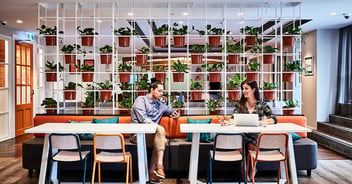At Axiom, company culture is central to what we do. Why? Because it is an essential component of business success, differentiating your values from that of your competitors, uniting your employees under a singular purpose, driving team performance, and promoting resilience.
Over the past two years, it’s fair to say company culture has had a huge shake-up, with employees forced to rapidly adapt to remote working due to the pandemic. This is something Australian businesses have done remarkably well, with many companies finding that productivity has actually increased over that time. As University of Michigan economics professor, Justin Wolfers, who is currently working from home in Australia, said to The Sydney Morning Herald: “Everyone is better off – no question. Total output has gone up.”
It’s no surprise, then, that as lockdown restrictions ease across the country, many companies are looking to continue the advantages of remote working with hybrid working environments. According to a survey by The Age and The Sydney Morning Herald, of the 50 companies they surveyed, 42 confirmed they will be permanently adopting hybrid working policies for office-based employees. This includes companies like the four major banks, Woolworths, Telstra and Afterpay.
So what does a remote company culture look like in a hybrid workplace model as we enter 2022 and beyond? To gain more insight into how company culture has changed, and how we can get the best of both worlds moving forward, we spoke to company culture expert and CEO of Culture Incorporated, Julie Alexander. Julie founded Culture Incorporated after her own demoralising experiences with company culture in the corporate world and is passionate about creating authentic company cultures where employees can bring their best selves to work and teams can thrive.
How has company culture and how we build that culture changed since the pandemic?
Looking back at this time of flux, it’s interesting to see how some companies have coped with this better than others. “Over time,” says Julie, “some of us have built life rafts, and some of us have built more permanent structures, but some of us are flapping around on the surface, not really sure what’s happening, and at the mercy of changing tides.”
One significant impact on company culture has been the loss of informal interactions. Managers have fewer opportunities to casually check in with employees, and those “watercooler” moments, where employees chat while making tea in the breakroom or on their way to a meeting, have been all but lost. “We’re getting less innovation, less spreading of ideas, less sourcing of ideas from other people, because we’re having less of those accidental incidental meetings and serendipitous chats.”
Remote working has also been particularly difficult for new starters, some of whom have never stepped foot in the office or physically met their co-workers, says Julie. Without the cues available in a physical environment – Is this an office where there’s lots of banter and laughter? Or do people prefer to sit quietly at their desks and get on with it? – it is difficult for new employees to get a handle on what the company culture is like. “There are also fewer opportunities to watch other people in action, to shadow them, and to be mentored on the job, in real-time,” she says. “Some of those opportunities haven’t necessarily translated well into the virtual environment – but there are other ways that you can do it.”
The companies that have managed the transition well are those that have been able to replicate those aspects of company culture in the virtual environment. PwC Australia, for example, use virtual reality (VR) headsets to train new employees, which they found was even more effective than training them in a classroom setting.
Canva was also able to take their social groups into the virtual. “These social groups were created by the Canva team, rather than being mandated from the top. Some people said, ‘I’ve got a love of wine’, and a social group was created around that. People would get together to have wine tastings, give each other recommendations and talk all things wine. When they moved to remote working, they carried the group on over Zoom, with bottles of wine being delivered to people’s homes.”
Similarly, “Zappos had a healthy eating club. And they translated that to remote working by sending people a kit that enabled them to grow their own produce at home. And they would all sit down and eat healthy meals together over Zoom.”
These examples show that there are ways to replicate even the most unique aspects of your company culture in a virtual environment – and retaining at least some of these moving forward to a hybrid work environment will be key to keeping remote workers engaged.
What is key to building a successful company culture in a hybrid work environment?
According to Julie, there are three things that are key to building a successful company culture in a hybrid work environment: a willingness to experiment, allowing for autonomy and flexibility, and providing an experience.
Experimentation
Julie says it’s important to approach building hybrid company culture with the right mindset, and that is “the mindset of ‘Let’s experiment.’ Nobody’s got the right answer. All we can do is try it.”
In this brave new world of hybrid working, it’s difficult to work out what will take, so employers need to think outside the box, be open to giving things a go, and be able to be agile when things perhaps don’t work out as planned.
“I think we need to have a sort of a broad vision for the future of how we think it might be, but then let people settle into that rhythm.”
Autonomy and flexibility
In the ‘old days’, it was more about ‘bums on seats’ – if people came in early, and left late, and spent the entire day at their desks, they were seen as doing a good job, whether their output reflected it or not.
But, as Julie puts it, “I don’t get paid to sit in a seat. You pay me to get a result, and to deliver on what it is that we’re trying to achieve overall – our vision, our goals.”
“I think we need to really push decisions out to the teams and start focusing on outputs,” she says. Workers should be able to decide what hours work best for them, and to work flexibly when they need to (e.g. to take half an hour off in the afternoon to pick up the kids from school), with the understanding that they have certain objectives they need to achieve in a given week.
She also strongly advises against using surveillance software that monitors remote workers. “When we start talking about how we can track the amount of time people are working and what they’re spending their time on, that for me is a massive red flag in terms of culture.”
Providing an experience
As shown by the examples of PwC, Canva and Zappo, there are ways in which companies can translate the employee experience to a virtual environment. The challenge for companies moving to remote company culture is how to create experiences for both in-office and remote workers while ensuring no one is getting left out.
Julie offers her own experience as an example: “I run these monthly sessions where I get people together to talk about company culture. We used to do them in physical office spaces all over Sydney CBD, so that people had a visceral experience of the culture in that location. When we went virtual, we asked ourselves, ‘How do we recreate that experience?’ Now, for some things, you just can’t. But we used to, for instance, provide a really healthy lunch. So we reached out to our caterer and said, ‘Can you create us a menu and then bring it to the virtual table, so to speak?’”
Of course, it’s not one-size-fits-all. What works for one organisation may not work for another. The key to providing good experiences for your employees, says Julie, is to involve the employees themselves. “This is an opportunity to get everybody to brainstorm and to think about what would make coming into an organisation better, what would improve the day-to-day and so on. This is also the opportunity to lead with questions, rather than try to provide all the answers.”
How can the physical office space support a strong company culture?
When it comes to a supportive hybrid working environment, it’s about enhancing those aspects that remote workers have been missing, but also providing those experiences they have grown to love about working from home. For example, you may think about increasing the areas where workers can socialise and collaborate, such as break areas, informal breakout rooms and collaborative workspaces.
Some workers have also been enjoying the peace and quiet of working from home, as well as the ability to mix things up by working in different areas of the house, such as at the dining table or in the backyard, so you may want to introduce quiet areas for deep concentration or provide places to work outside if you’re lucky enough to have an outdoor balcony or courtyard.
One of the challenges for many businesses will be dealing with the fluctuating numbers of employees in the office. You may, for example, have certain days of the week, month or year when all employees are expected to come into the office, and during busy periods more employees may opt to come in too. One way to manage this would be by creating flexibility in the physical office space – for example, moveable walls that allow you to accommodate large town hall meetings, and readjust to create more intimate meeting rooms. It’s also important that your tech is able to deal with this flux of employees, in order to promote digital inclusion.
Our recommendations for flexibility to be embedded in the office design and support the culture for whatever companies need, malleable & personalised workstations to suit an evolving work environment, walls that could be moved to create different-sized rooms, and agile meeting rooms with a user-friendly booking system to accommodate all types of meetings, from one-on-ones to 20-person meetings. “I think that’s the space of the future,” says Julie. “To support the culture, the space has to have that flexibility to morph itself into whatever people need.”
As businesses prepare to get workers back in the office, the hybrid company culture is right around the corner. Is your business ready? To learn more about the new norm of hybrid working, check out our comprehensive article, ‘Leading the Future of Work in Australia’.






